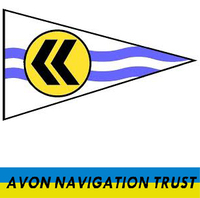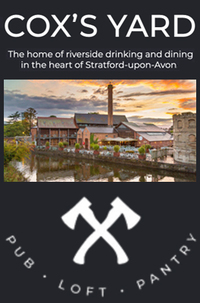


Local Sponsors
-
Avon Navigation Trust
Mill Wharf, Mill Lane Wyre Piddle WR10 2JF
The navigable river Avon runs from Alveston Weir above Stratford-upon Avon, for 47 miles, winding it's way through the Warwickshire, Worcestershire, and Gloucestershire countryside, down to Tewkesbury where it joins the river Severn.
-
Cox's Yard
Bridge Foot, Stratford-upon-Avon. CV37 6YY
Situated on the beautiful river Avon just a stone’s throw from the centre of town, you’ll be hard pushed to find a better location to relax. Cox’s Yard leaves you spoilt for choice, boasting an all fresh food restaurant with a fantastic range of beers and wines, not to mention our Coffee Shop, offering cakes, light bites and homemade Gelato. We are named after James Cox, a timber merchant who moved to the site to develop his fledgling business over 160 years ago. James Cox and Sons became well known in the area for supplying the finest materials, many of which were used to build today’s historic building in Shakespeare’s County. Whilst we obviously no longer trade in timber, we do serve delicious food and drink, made from the finest ingredients, that’s not to be missed!
More information
Stratford Trinity Lock, also recognized as Colin P. Witter Lock and once humorously characterized by a councilwoman as "Mr. Hutchings' monumental structure in the park," posed unique challenges during its construction due to its exceptional depth and the unstable ground conditions (referred to as a silt pit). These difficulties necessitated the use of unconventional girders to stabilize the lock, with labor primarily carried out by individuals from Gloucester Gaol and other dedicated volunteers. Positioned on the River Avon in Stratford-upon-Avon, this lock stands as the most upstream lock along the river.To distinguish it from other navigable river Avons like the Bristol Avon, the waterway is commonly denoted as the Stratford Avon.Dating back to the late 1630s, the river was made navigable from the River Severn at Tewkesbury to Stratford. However, the Upper Avon section, spanning from Evesham to Stratford, faced decline with the advent of railways and eventually fell into disuse post-1875. It was not until 1974 that the route was meticulously restored and officially reopened by Her Majesty Queen Elizabeth The Queen Mother.Each of the locks along this stretch bears the name of a benefactor who contributed either financially or through active involvement during the restoration process. These double-width locks, totaling 17 in number, are strategically positioned across the 45 ½ miles stretching from Tewkesbury to Alveston, offering essential navigational structures along the picturesque waterway. The Collegiate Church of the Holy and Undivided Trinity in Stratford-upon-Avon, Warwickshire, England, stands as a Grade I listed parish church of the Church of England. Revered as Holy Trinity Church or Shakespeare's Church, it holds notable significance as the site where William Shakespeare, the renowned playwright, was baptized, married, and buried. Drawing more than 200,000 visitors annually, this historic church dates back to 1210 and is constructed upon the grounds of a former Saxon monastery, making it the oldest edifice in Stratford. Situated by the tranquil banks of the River Avon, it ranks among the most frequented churches in England.During the fourteenth century, John de Stratford established a chantry at the church, later reconstructed between 1465 and 1497 by Dean Thomas Balshall, interred within the church. Originally featuring a wooden spire, it was refashioned by William Hiorne in 1763. William Shakespeare, the esteemed poet and playwright, was baptized at Holy Trinity on April 26, 1564, and laid to rest there on April 25, 1616. The church retains the original Elizabethan registry documenting his baptism and burial, safeguarded by the Shakespeare Birthplace Trust.Laid to rest in the 15th-century chancel erected by Thomas Balsall, Shakespeare was accorded burial within this sacred space due to his role as a "lay rector" of the church, a privilege granted for his leasing of tithes. His funerary monument adorns a wall near his final resting place, refurbished in 1746 using funds from an Othello production, marking the inaugural recorded Shakespearean play performance in Stratford-upon-Avon.Shakespeare's routine included visits to Holy Trinity each week during his stays in town, spanning his formative years and his later residence at New Place. Alongside him lie his wife Anne Hathaway and their eldest daughter Susanna. Shortly after signing his Last Will and Testament on March 25, 1616, Shakespeare's son-in-law Thomas Quiney faced public censure within the church for his involvement in a scandal, coinciding with Shakespeare's passing and subsequent funeral on April 25, 1616, held at Holy Trinity.



